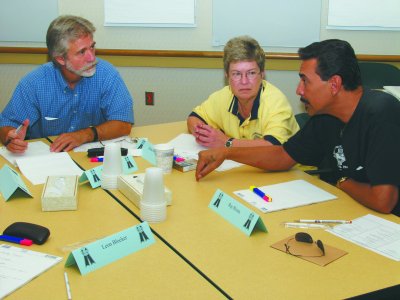|

Blue Ribbon Commission members met to draft the final
report. From
left, Richard Borque, Diane Boyd and Ray Rivera.
Eight years ago, the IAM created
the first of three Blue Ribbon Commissions. Relying on IAM
members' insights and wisdom, the Commissions ensure that the
IAM survives society's increasing pace of change.
Each Blue
Ribbon Commission, in 1995, 1998 and 2002, had the same goal:
Listen to what the members had to say about what is working well
in the union; what isn't working well; and what changes are
needed.
Commission
members from all levels of the IAM held town-hall style meetings
across the United States and Canada. Each meeting was open to
any member who wanted to voice their opinion.
Commission
members listened and then compiled the membership's comments
into a final report.
Final
Commission reports in 1995 and 1998 became a blueprint for
innovative change. They led to the creation of the Aerospace,
Women's, and Collective Bargaining Departments. Education and
training capacity at the William W. Winpisinger Education was
doubled with the addition of a new wing and more staff.
New
communications tools were implemented, such as a redesigned web
site and web-based video on demand. Delegates to the 2000 Grand
Lodge Convention approved Communicator and Educator positions in
every local and district lodge.
The 2002
Blue Ribbon Commission Final Report will be a similar roadmap
for new initiatives. "Our members told us what must be changed,"
said Commission Chairperson General Vice President Robert
Thayer. "We will use their ideas to keep the IAM a strong,
progressive union."
Several
clear themes emerged in member comments about what they feel is
working and not working in the IAM. They had universal praise
for the William W. Winpisinger Education and Technology Center
and appreciated the increased availability for training.
Innovative communications such as the new web page, iMail, Have
you Heard?, the IAM Journal and the ability to send email
messages to legislators from the web site drew favorable
reviews.
Members
liked the increased amount of information available and the
increased training and education at the local and district level
with the new Educator and Communicator positions, which one
member credited as an "original idea which no other union has."
Members
thought that IAM departments and programs were effective and
they gave high marks to the IAM National Pension Plan. They
praised the Blue Ribbon Commission members for holding meetings
that covered multiple shifts and heard from "all walks of the
organization." They also appreciated that the IAM listens and
acts on their concerns.
Other strong
themes emerged about what members thought wasn't working well.
Many voiced concern that smaller locals are "not getting the
same level of attention and support as larger locals." They
noted the negative impact on local finances of the current per
capita structure and had problems with local and district lodge
mergers. Some cited problems with the limitation on the use of
absentee ballots in union elections and noted the amount and
timing of strike pay.
Many members
wanted to see more of their representatives, and they felt their
increased presence would be a plus in contract enforcement,
grievance handling, and negotiations that dealt with job
security and outsourcing.
Members want
more communications, especially during contract negotiations,
and they want more IAM visibility in the public media.
Apathy and
lack of involvement, especially by members who know little about
unions, were cited as key concerns. Members want more
information about political candidates and they cited the need
for more support for organizing.
"The 2002
Blue Ribbon Commission members worked hard and we are proud of
their efforts," said IAM President Tom Buffenbarger. "Our
members spoke up and we will listen. I thank them for taking the
time to attend a town hall meeting and speaking out."
|